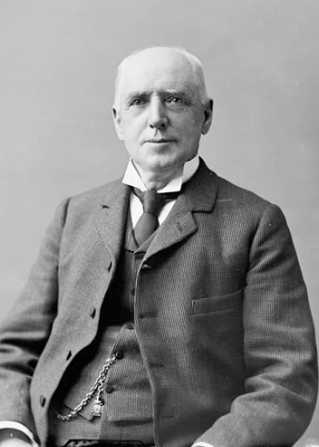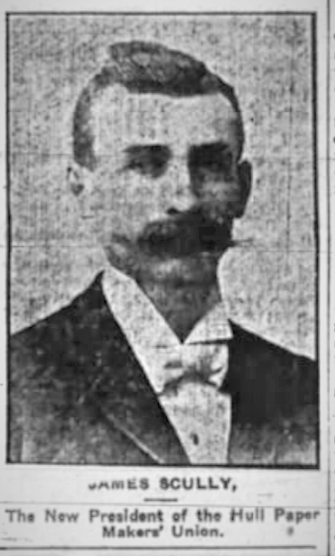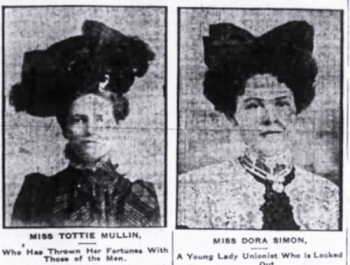11 January 1904
The great fire of 1900, which gutted most of Hull and LeBreton Flats in Ottawa, destroyed much of E.B. Eddy’s paper works located near the Chaudière Falls. However, within six months of the disaster, the eponymous E.B. Eddy Company was back in operation thanks in no small measure to the iron determination of its owner.
Ezra Butler Eddy was a man of many parts—a self-made entrepreneur, philanthropist, politician and church-going Presbyterian. By the early 1900s, his firm employed more than 2,000 people in his pulp, paper, and match empire. His paper and fibre products were sold across the Dominion. He owned exclusive cutting privileges to more than 1,000 square miles of timber land in the region. At various times, he was mayor of the City of Hull, and member of the Quebec legislature for the county of Ottawa. In other words, he was a powerful man.
He was also as hard as nails. He had to be to get to where he was in the rough and tumble lumber business. He ran his company accordingly. By his lights, he was a fair man, giving employment to the people of the region and paying competitive wages. His company was an “open shop,” hiring union and non-union men to run the paper-making machines. Eddy said he had nothing against unions. He was probably telling the truth, being a proud, honorary member of the Ottawa Bricklayers’ Union, an accolade he received after the great fire.
 Ezra Butler Eddy, Topley Studios, Library and Archives Canada, 3468801.In addition to E.B. Eddy’s iron will, the quick recovery of his factories after the 1900 fire was also due to the hard work of his employees. They laboured long hours, longer than they had prior to the fire. The mills were in operation from Monday morning at 7:00 am to Sunday morning at 5.30 am. There were only two shifts. The day shift ran 78 hours per week, the night shift 65 hours. The men alternated shifts, sharing the difference in hours. On average, the men worked approximately twelve hours per working day, six days out of seven. There was no break for meals. By June 1901, the men had had enough. They wanted shorter hours with the same pay. Eddy refused, claiming losses sustained in the fire as the reason. The issue of shorter hours was put on the back-burner.
Ezra Butler Eddy, Topley Studios, Library and Archives Canada, 3468801.In addition to E.B. Eddy’s iron will, the quick recovery of his factories after the 1900 fire was also due to the hard work of his employees. They laboured long hours, longer than they had prior to the fire. The mills were in operation from Monday morning at 7:00 am to Sunday morning at 5.30 am. There were only two shifts. The day shift ran 78 hours per week, the night shift 65 hours. The men alternated shifts, sharing the difference in hours. On average, the men worked approximately twelve hours per working day, six days out of seven. There was no break for meals. By June 1901, the men had had enough. They wanted shorter hours with the same pay. Eddy refused, claiming losses sustained in the fire as the reason. The issue of shorter hours was put on the back-burner.
About this time, the International Brotherhood of Papermakers set about organizing the Eddy workers. In 1902, the local branch of the union asked for shorter hours for Eddy’s papermakers. Again, the company said no since it would mean the loss of 50-60 tons of paper per week. Mr. Eddy also claimed that his company was already paying its employees the “highest wages going.” However, after lengthy negotiations, the company agreed to give shorter hours a “fair trial,” staring in January 1903. On average, the workers would work eleven hours per day for the same pay. The mills would close at 5.30 pm on Saturday. There was a catch however. According to Mr. Eddy, workers would have to become more productive, offsetting the lost production owing to the shorter hours. The workers said they would try their utmost to do so.
Initially, all seemed to go well. During the summer of 1903, Eddy appeared satisfied with his employees’ effort. But then things began to sour. A demand by workers for a pay increase was rejected. Instead, Eddy informed them that unless production increased during the remainder of the year, the short-hour system would be discontinued.
At the beginning of January 1904, paper mill superintendents gathered their men and read them the bad news which was contained in a circular to all employees. The circular claimed that average daily output through the previous year had been neither what the workers had promised, nor what the company had expected. Consequently, the hours of employment would henceforth run from Monday, starting at 6.30 am, until midnight Saturday.
There had been no consultation or discussion with the union, or mill workers at large. With only two shifts, this change increased the average work week by roughly thirty minutes to 11 ½ hours. Eddy also urged papermakers to “try in every way to bring it [output] up to what it should be for the wages paid, the class of machinery installed and the facilities we have.” Wages for men in the plant ranged from $1.25 per day to $3.25 per day. Most were at the lower end of the scale. In contrast, top corporate officials were well compensated, with at least one earning $10,000 per year.
Members of the union, Hull Lodge No. 35 of the International Brotherhood of Papermakers, met to discuss Eddy’s statement. The union members said that despite the shift to shorter hours a year earlier, they were still working eleven hours per day while other trades were working ten hours or even eight to nine hours. Consequently, they could not comply with Eddy’s order to work still longer hours. They recommended that the company move to a three-shift system which would permit the paper-making machines to be used more intensively, but at the same time would allow for a shorter work week. The union also noted that seven other Canadian paper mills had introduced the shorter-hour system without reducing wages.
Eddy refused. He replied that the only way his company would return to the shorter hours would be if the men took a proportional reduction in wages. He added that the company had considered the matter fully, and that it was in the best interest of the employees to increase the number of hours worked rather than cut wages. That Saturday afternoon, the company issued an ultimatum. If the paper workers didn’t obey the order, they should consider themselves “discharged.”
The papermakers downed tools as usual at 5.30 pm, ignoring the order to work to midnight.
The next day, at High Mass at Notre Dame de Grâce in Hull, Rev. Father Duhau urged the men to return to work. He argued that prolonged idleness would entail suffering for families in the middle of winter. The Church would not support the men’s demand for shorter working hours.
On Monday, 11 January 1904, men reporting for work found they were out of a job. They were greeted by notices posted in both English and French saying that the company would accept applications from its “late employees” for re-engagement until the following Saturday. After that, it would proceed to fill all vacancies with other workers. The men had effectively been locked-out.
None of the union paper workers applied to be re-hired. Instead, they began to meet daily to discuss events, play cards, and smoke in a local hall. The men were enjoying the first real leisure that had had for years. A dance was organized for the workers at the Hull City Hall.
More than four hundred papermakers were affected by the lockout. A further one hundred other workers—teamsters, shippers, and finishers—were laid off. Women joined the labour fight. Miss Tottie Mullin, and Miss Dora Simon, both veteran employees of the finishing room of the paper mill who had been laid off, joined the union.
The company’s deadline for re-hiring the paper workers passed without any of the union workers applying for their old jobs despite the Church again urging them to return to work under Eddy’s terms. Rev. Father Fréchette of Notre Dame de Grâce said that if farmers could work thirteen hours a day, he couldn’t see why the papermakers couldn’t do the same. The union said the conditions in the mills were not analogous to those in the fields.
A delegation of workers went to discuss matters with Mr. Eddy in person. The conversation was polite but terse. Eddy had a stenographer record the meeting verbatim. Eddy said that the men had the perfect right to chose not to work and leave his employ. At the same time, he had the right to run his business the way he wanted. Nobody, not even the Governor General, would dare to interfere, he said. He subsequently denied that he was fighting the union, saying that he was instead fighting for freedom.
You would think that there would be a lot of hard feelings towards Eddy within the community. Surprisingly, several wives of locked out workers told an Ottawa Citizen journalist that the E.B. Eddy Company was the finest in Canada. While they “kick against the extra hours of work and no pay with it, we haven’t a word but kindness to say of him.”
There were, however, complaints about working conditions in the mills. One woman commented that papermakers don’t live long at the mills. “I’ve never seen an old man there.” Workers were also liable to be hurt or maimed for life “if they are caught in the clippers.” Recall, this was long before workman’s compensation. Another complained that the men had to eat while working the machines. “They just spread the food out where they can reach it.” The mills were also so hot that men had to strip down to “no more than the law calls for.” While Eddy thought the men were well compensated, wives complained that men with big families couldn’t afford to send their children to school. The monthly fee of 20 cents per month per child for books was simply more than they could afford. Consequently, kids as young as thirteen had to go to work for less than a dollar a day.
The labour dispute went on for months. After the third week, the union began paying benefits to the locked-out workers–$3 per week to unmarried men, and $5 per week to married men. The union kept order so that the men didn’t hang around street corners or caused any disruption. There was no picketing.
 James Scully, President of the Hull Lodge of the International Brotherhood of Papermakers, Ottawa Journal, 13 January 1904.A circular was sent out by James Scully, the president of the Hull branch of the papermakers’ union, and Harry Smith, the union’s secretary, seeking the support of organized labour. This public letter, which was published in the Ottawa Journal, was endorsed by P.M. Draper and C.S.O. Boudreault, the president and secretary, respectively, of the Allied Trades and Labour Council of Ottawa. Its authors wrote that Eddy had “without any regard for the severity of a bitter Canadian winter turned out his employees to suffer, or to die.” They also claimed that the attitude of Eddy had “opened the eyes of all, that certain capitalists take no concern in the material interests of their employees, but seek one and only one thing, their own wealth and the satisfaction of a greed for money.”
James Scully, President of the Hull Lodge of the International Brotherhood of Papermakers, Ottawa Journal, 13 January 1904.A circular was sent out by James Scully, the president of the Hull branch of the papermakers’ union, and Harry Smith, the union’s secretary, seeking the support of organized labour. This public letter, which was published in the Ottawa Journal, was endorsed by P.M. Draper and C.S.O. Boudreault, the president and secretary, respectively, of the Allied Trades and Labour Council of Ottawa. Its authors wrote that Eddy had “without any regard for the severity of a bitter Canadian winter turned out his employees to suffer, or to die.” They also claimed that the attitude of Eddy had “opened the eyes of all, that certain capitalists take no concern in the material interests of their employees, but seek one and only one thing, their own wealth and the satisfaction of a greed for money.”
Eddy did not take this lying down. He quickly filed a $50,000 law suit for libel against the four signatories of the letter. He also demanded an immediate apology from the Ottawa Journal. The next day, the newspaper complied. While voicing its continued support for the papermakers, the newspaper said that the circular contained a number of false statements which discredited the union. The newspaper offered an abject apology to the company and in particular to Mr. Eddy. The Ottawa Citizen exulted that its competitor had to eat “a generous sized dish of crow.”
Using six non-union workers, Eddy got one of his great paper-making machines working within just a couple of days of the start of the lock-out. Within a few weeks, all seven of its machines were up and running. By mid February 1904, sufficient paper was being produced that Eddy could meet all his contracts.
Many of the company’s former employees drifted away, some to the shanties in the woods cutting timber. In late April 1904, the Hull Lodge, No. 35 of the International Brotherhood of Papermakers threw in the towel. A resolution of its members, signed by James Scully and Harry Smith, said that the fight for shorter work hours had been discontinued. Moreover, they asked that “any hard feeling that may have arisen through this trouble be allowed to drop and the same cordial relations shall exist between your company and your former employees, that existed previous to this trouble.”
It would appear that Eddy subsequently dropped his $50,000 libel suit against Scully, Smith and the leaders of the Allied Trades and Labour Council. Eddy died in early 1906 at the age of seventy-eight.
In June 1913, nine years after the lock-out, the E.B. Eddy Company announced that the two-shift system of eleven and thirteen hours used in its book paper division would be discontinued in favour of three eight-hour shifts. The three-shift system had been adopted a few months earlier for newsprint makers. The company said that it wanted to improve the working conditions of its employees. The three-shift system was exactly what the papermakers had recommended in 1904.
Sources:
Manitoba Free Press, 1904. “Work at Eddy Mill,” 15 January.
Ottawa Citizen, 1904. “Eddy Mills Lock Out,” 11 January.
——————, 1904. “Dramatic Interview With the Employes (sic),” 20 January.
——————, 1904. “Eddy Paper Makers’ Strike,” 25 January.
——————, 1904. “Severe on Mr. Eddy,” 25 January.
——————, 1904. “Writ For Damages,” 8 February.
——————, 1904. “The Hull Strike,” 16 February.
——————, 1904. “On The Timber Limits,” 22 February.
——————, 1913. “Gets Three-Eight-Hour Shifts,” 29 May.
Ottawa Journal, 1904. “Lockout At The Big Eddy Paper Mills,” 11 January.
——————-, 1904. “Ultimatum To Paper-Makers,” 13 January.
——————-, 1904. “The Eddy Company Start One Machine,” 14 January.
——————-, 1904. “Men Did Not Heed The Company’s Ultimatum,” 18 January.
——————-, 1904. “Still For Open Shop,” 19 January.
——————-, 1904. “Eddy Strike Not Settled,” 21 January.
——————-, 1904. “An Appeal For Assistance,” 1 February.
——————-, 1904. “The Eddy Strike,” 3 February.
Vancouver Daily World, 1904. “Eddy Will Sue Labor Leaders,” 6 February.
Story written by James Powell, the author of the blog Today in Ottawa's History.
Retired from the Bank of Canada, James is the author or co-author of three books dealing with some aspect of Canadian history. These comprise: A History of the Canadian Dollar, 2005, Bank of Canada, The Bank of Canada of James Elliott Coyne: Challenges, Confrontation and Change,” 2009, Queen’s University Press, and with Jill Moxley, Faking It! A History of Counterfeiting in Canada, 2013, General Store Publishing House, Renfrew, Ontario. James is a Director of The Historical Society of Ottawa.






